Pediculosis, or juon ki bimari (जूँ की बीमारी) in Hindi, refers to an infestation of lice. While pediculosis can affect different body areas, the term most commonly describes head lice infestation, a prevalent issue, especially among children. Understanding pediculosis meaning in Hindi helps in addressing the social stigma and seeking effective treatment. This article delves into the meaning, symptoms, causes, and treatment options for pediculosis, empowering you to tackle this common problem.
What Does Pediculosis Actually Mean?
Pediculosis is derived from the Latin word “pediculus,” meaning “louse.” These tiny, wingless insects are parasitic, meaning they survive by feeding on human blood. They are highly contagious, spreading quickly through close contact or sharing personal items like combs, hats, or bedding. Knowing the pediculosis meaning in Hindi – juon ki bimari – can help initiate conversations and raise awareness about this often-misunderstood condition.
Types of Pediculosis and Their Hindi Equivalents
While head lice are the most common, pediculosis can also manifest in other forms:
- Head lice (sir ki juen – सिर की जूँ): These lice infest the scalp and hair.
- Body lice (badan ki juen – बदन की जूँ): These lice live in clothing and bedding, moving onto the skin to feed.
- Pubic lice (jhanghon ki juen – झाँघों की जूँ): These lice infest the pubic hair and surrounding areas.
Understanding the different types and their corresponding terms in Hindi is crucial for accurate diagnosis and treatment.
Symptoms: Recognizing the Signs of Pediculosis
Itching is the most common symptom of head lice, caused by an allergic reaction to louse saliva. Other signs include:
- A tickling feeling of something moving in the hair.
- Visible lice or nits (louse eggs) on the scalp or hair shafts.
- Small red bumps or sores on the scalp, neck, and shoulders.
 Pediculosis Symptoms
Pediculosis Symptoms
Causes and Transmission of Pediculosis
Head lice spread primarily through direct head-to-head contact. Sharing personal belongings like combs, brushes, hats, scarves, and bedding can also transmit lice. While not a sign of poor hygiene, crowded living conditions can increase the risk of infestation.
Treatment Options for Pediculosis
Several effective treatments are available to eliminate head lice and nits. These include:
- Over-the-counter (OTC) medications: These contain insecticides that kill lice and nits.
- Prescription medications: For resistant cases, stronger prescription medications might be necessary.
- Wet-combing: This involves meticulously combing through wet hair with a fine-toothed comb to remove lice and nits.
- Home remedies: Some natural remedies like tea tree oil or neem oil are believed to have insecticidal properties. However, their efficacy varies.
Preventing Pediculosis: Practical Tips
Prevention is key in managing pediculosis. Here are some practical tips:
- Avoid head-to-head contact with infested individuals.
- Do not share personal items like combs, brushes, hats, and bedding.
- Regularly check your child’s hair for lice and nits, especially during outbreaks at school or daycare.
- Wash bedding and clothing in hot water and dry on high heat.
What to Do if You Suspect Pediculosis
If you suspect you or your child has head lice, consult a doctor or pharmacist for proper diagnosis and treatment recommendations. Early detection and treatment are crucial to prevent the infestation from spreading.
Conclusion: Managing Pediculosis Effectively
Understanding pediculosis meaning in Hindi and its various aspects empowers you to take proactive steps in managing this common condition. By recognizing the symptoms, understanding the causes, and utilizing appropriate treatment and prevention strategies, you can effectively address pediculosis and minimize its impact on your and your family’s well-being.
FAQ: Frequently Asked Questions about Pediculosis
- Is pediculosis contagious? Yes, pediculosis, particularly head lice infestation, is highly contagious.
- Can pets spread pediculosis? No, human lice cannot survive on pets and vice-versa.
- Does pediculosis indicate poor hygiene? No, pediculosis can affect anyone regardless of their hygiene practices.
- How long does it take to treat pediculosis? Treatment duration varies depending on the chosen method and the severity of infestation.
- Can I use home remedies to treat pediculosis? Some home remedies may help, but it’s crucial to consult a healthcare professional for effective treatment.
- How can I prevent pediculosis? Avoiding head-to-head contact, not sharing personal items, and regular checks are crucial for prevention.
- What should I do if my child gets head lice at school? Inform the school authorities and follow their guidelines for managing the outbreak.
Meaning-Hindi.in is your trusted partner for all your Hindi translation needs. We specialize in various translation services, including business and commercial documents, legal and certified translations, technical manuals, website localization, educational and academic materials, and express translation services across different specializations. Our team of expert Hindi linguists ensures accurate, culturally sensitive, and high-quality translations. For professional Hindi translation services, contact us at [email protected] or call us at +91 11-4502-7584. Connect with Meaning-Hindi.in for all your Hindi language solutions.